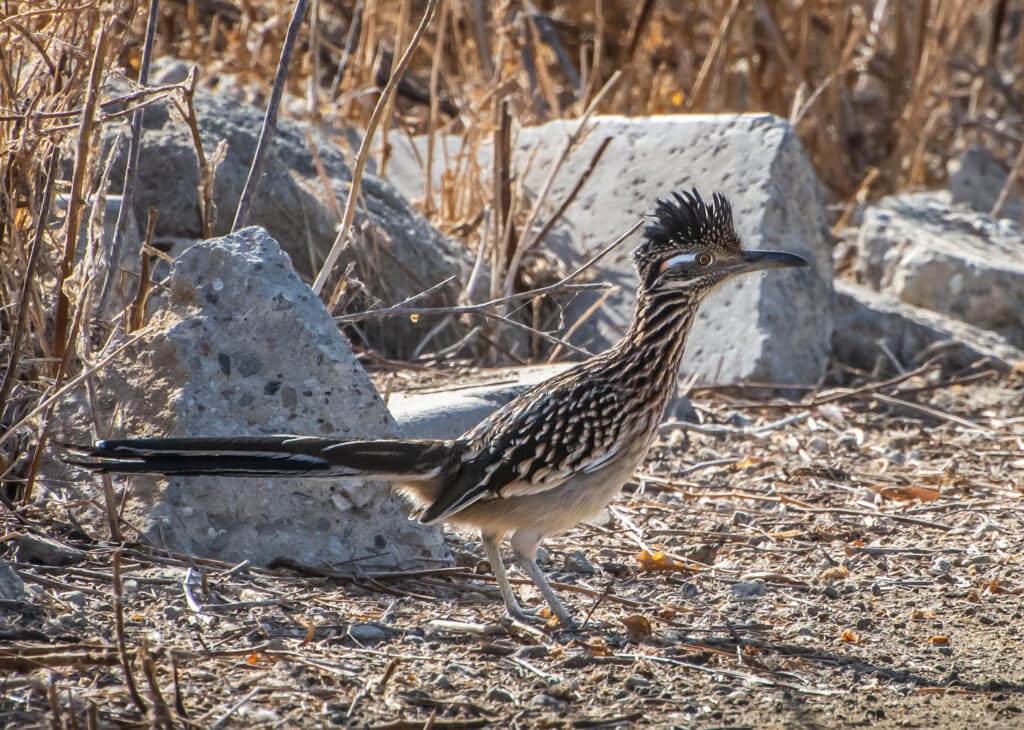In the cartoons, the Roadrunner is always one step ahead. It zips through the desert, avoiding the hare-brained machinations of its coyote enemy with an easy-going smile. This goofy fan favorite character bears little physical resemblance to actual Roadrunner birds, but if you study these birds you might find that the indomitable spirit of the Roadrunner isn’t too far off the mark.
The Greater Roadrunner’s scientific name is “Geococcyx californianus” which means “California earth-cuckoo.” This is accurate, as these birds belong to the Cuculidae family of the cuckoo birds. Roadrunners are also largely terrestrial. They are capable of flight, but do not fly more than necessary and have been observed to fly poorly.
Related Article: Barred Owls Are Breeding in Wyoming for the First Time
Fun Facts About the Greater Roadrunner
Life in the deserts of the American Southwest, where the Greater Roadrunner makes its home, can be unforgiving. Such a harsh environment often leads to unique physical adaptations that allow the local fauna to thrive under punishing conditions. Necessity, after all, is the mother of invention. The Greater Roadrunner’s unique and impressive physical abilities embody life in the deserts of the Southwest. Let’s examine some of the Roadrunner’s most interesting traits.
- Meep meep! It’s not just the cartoon that’s speedy: The Looney Tunes Roadrunner is famous for its speed. This detail, at least, is somewhat true to life. Though the maximum speed of a coyote is fast enough to overtake it, the Roadrunner’s ability to run at top speeds of up to 26 miles per hour makes it faster than the fastest human alive. In fact, amongst birds who are capable of flight — so excluding the ultra-fast flightless ratite family including ostriches and emus — the Greater Roadrunner is the fastest running bird around.
- Salty tears conserve water: Water is a hot commodity in the desert and a constant challenge for desert wildlife. While some animals store water in their bodies, like the camels that roam the deserts of Eurasia and North Africa, others find clever ways to conserve the little water they get. Most of the water that a Greater Roadrunner gets comes from its diet. With so little water to spare, secreting it through the kidneys and urinary track is a bit of a waste. But urination is important for the removal of excess salt. So, the Greater Roadrunner has developed an ability that solves this conundrum. Instead of producing urine, these birds secrete salt through a special gland in their eyes. Unlike urine, this solution removes very little water from the body.
- Romance under the desert sun: The Greater Roadrunner may not look like a hopeless romantic, but these birds often mate for life. Part of the courtship process for Greater Roadrunners involves gift-giving. Both sexes will give each other small offerings of sticks or blades of grass. Additionally, males may perform a dance for females that involves running, raising and lowering their wings, and bowing.
- Slayer of snakes: Roadrunners are famous for their unbelievable ability to face down and kill rattlesnakes. While this feat may sound larger than life, it is actually true, though Greater Roadrunners often need to work in pairs to finish off a deadly rattlesnake. Although this is a real behavior, rattlesnakes are by no means the preferred prey of the Greater Roadrunner. In fact, Greater Roadrunners are far from picky and will eat anything from mammals to snakes to insects to lizards. Much like the rattlesnake, many of the Greater Roadrunner’s common prey are venomous or poisonous. Roadrunners do not seem to be affected by this and eat venomous scorpions and snakes without hesitation.
- X marks the spot: Like all cuckoos, the Greater Roadrunner has zygodactyl feet. This means that unlike the classic passerine foot that songbirds have, where three toes point forward and one points backwards, Roadrunners’ toes are arranged in pairs with two pointing forward and two pointing backwards. This means that they leave X-shaped footprints. In some Native American cultures, these X-shaped prints are thought of as sacred symbols representing protection from evil. It is said that because the Roadrunner’s footprints are symmetrical, evil spirits cannot tell which direction they are facing and are unable to follow these birds.
The Future of the Greater Roadrunner
Greater Roadrunners are considered to be of “least concern” according to the International Union for the Conservation of Nature’s Red List of Endangered Species. Overall, populations of this bird seem to be stable, and may even be increasing in some areas. In parts of their range, long-term decline has been reported. Because Roadrunners rely on large desert territories to thrive, responsible land management practices throughout the Southwest are key to the continuing success of this special bird.
Popular Article: Species Spotlight: The Shoebill Stork

